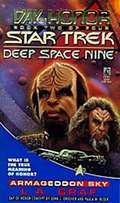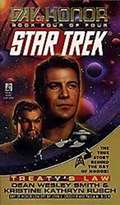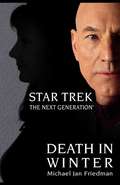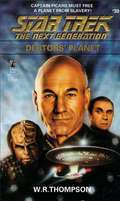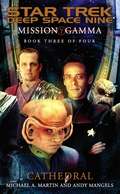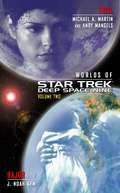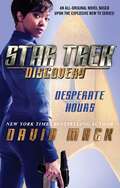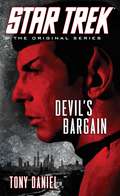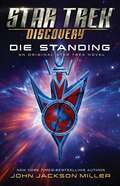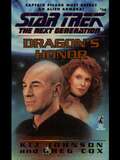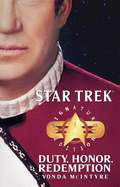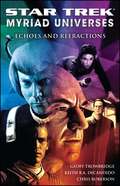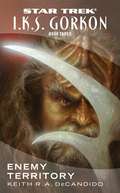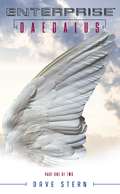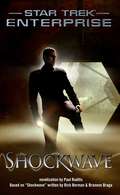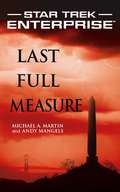- Table View
- List View
Star Trek: Day of Honor #2 (Star Trek: Deep Space Nine #2)
by L.A. GrafWorf and the USS Defiant find themselves in a deadly trap in this suspenseful and white-knuckled thriller in the bestselling Day of Honor series taking place in Star Trek: Deep Space Nine. Dispatched on a secret mission, Commander Worf and the crew of the USS Defiant find themselves trapped—along with the exiled Klingons who had pledged their loyalty to Worf&’s dishonored family—on an alien world threatened by a global cataclysm. Worf must find a way to save himself and his fellow Klingons and also prevent a bloody massacre that will forever stain the honor of the Klingon Empire.
Star Trek: Day of Honor #4 (Star Trek: The Original Series #4)
by Kristine Kathryn Rusch Dean Wesley SmithDiscover the beginnings of Klingon&’s most sacred holiday in this thrilling entry in the bestselling Star Trek series. Signi Beta is an M-class planet ideal for farming. The Federation wants it, but the Klingon Empire has the stronger claim. Captain Kirk of the USS Enterprise hates to lose the planet, especially to his old adversary, Commander Kor. Their mutual antagonism turns into an uneasy alliance, however, when yet another alien fleet attacks both the Klingons and the USS Enterprise. Now Kirk and Kor must rely on each other&’s honor—or none of them may survive to wage their war again.
Star Trek: Death in Winter (Star Trek: The Next Generation)
by Michael Jan FriedmanLong before Captain Jean-Luc Picard took command of the legendary Starship Enterprise, he fell deeply and hopelessly in love with Doctor Beverly Crusher. Though, for one reason or another, Picard never acted on his feelings, he found a measure of contentment as Beverly's close friend, colleague, and daily breakfast partner. But when Doctor Crusher leaves her position on the Enterprise to become the chief medical officer of Starfleet, the brightest light in Picard's life is taken from him. And he has hardly resigned himself to his loss when he learns that Beverly has been declared missing in action on a distant planet -- and presumed dead. Kevratas is a bleak, frozen world on the far side of the Romulan Neutral Zone where the Federation has become the plague-ravaged natives' only real hope of survival and freedom. Starfleet has no recourse but to send in another team to try to save the Kevrata -- and Picard is the natural choice. Critical to the success of his mission are two colleagues who served under him when he commanded the Starship Stargazer -- Pug Joseph, a man with a past to live down, and Doctor Carter Greyhorse, who has served time for attempted murder -- as well as a Romulan who left his people years earlier and never expected to return. Together, they follow the trail of Beverly Crusher to Kevratas, determined to succeed where the doctor failed. On the Romulan homeworld, meanwhile, the political vacuum created by the demise of Praetor Shinzon has been filled by his staunchest supporter, Senator Tal'aura. But there are those who oppose her, including Commander Donatra and the warbird fleets under her command, because of the way Tal'aura has mishandled rebellions on the Empire's subject worlds. And one rebellion in particular; the movement for self-determination on frigid Kevratas. So begins a desperate struggle -- not only for the freedom of the long-oppressed Kevrata but also for the soul of the Romulan Empire. Before it's over, destinies will be forged and shattered, the Empire will be shaken to its ancient foundations, and Jean-Luc Picard's life will be changed...forever.
Star Trek: Debtor's Planet (Star Trek: The Next Generation #30)
by W.R. ThompsonWhen a Vulcan space probe reports that the Ferengi are advancing the people of the planet Megara from a primitive agricultural state to a sophisticated technological society, Captain Jean-Luc Picard and the Starship Enterprise are ordered to transport an unlikely passenger to the system, a ruthless twentieth-century businessman who is now a Federation ambassador. The Ferengi have been changing Megaran culture, turning a hard working and horoable people into vicious xenophobic killers. But the Ferengi are only hired hands. They have hidden masters, with plans to use the Magaran people as a powerful weapon against the Federation. Now Picard must find a way to use the talents of this new ambassador to free the Megarans. But the ambassador is hididng a deadly secret of his own -- a secret that could unleash an unstoppable destructive force on the Federation.
Star Trek: Deep Space Nine (Mission: Gamma #3)
by Andy Mangels Michael A. MartinSIREN SONGS As a small child, Jules Bashir underwent illegal genetic enhancements that forever altered the natural course of his life. As an adult, ever since the day he discovered what his parents had done, Dr. Julian Bashir has wondered what he might have become if "Jules" had been allowed to live, certain he would never know the answer. But when the lure of a strange alien artifact in the Gamma Quadrant inexplicably begins to reverse Bashir's enhancements, the person he had thought long dead is given a second chance at life. Ninety thousand light-years away, as the crew of Deep Space 9 tries to comprehend a shocking tragedy, Ro Laren makes a fateful decision about her life aboard the station. And although political maneuverings and failing diplomacy have already extinguished all hope of a real, lasting peace between Bajor and Cardassia, one man's search for his true calling may lay a new foundation for the future.
Star Trek: Deep Space Nine: Fearful Symmetry (Star Trek: Deep Space Nine)
by Olivia WoodsIn our universe, a Cardassian sleeper agent--Iliana Ghemor--was once surgically altered to resemble and replace resistance fighter Kira Nerys, future Starfleet captain and hero of the planet Bajor's liberation. That plan never reached fruition, and the fate of the agent remained unknown...until now. Robbed of the past sixteen years, Iliana Ghemor is back with a vengeance. Over a decade and a half of imprisonment and abuse by her former masters has brought her to the brink of madness, sustained only by the twisted belief that she is, in fact, the real Kira Nerys. She has already made one near-successful attempt on the real Kira's life, but instead of assuming the identity of the woman she was intended to replace, Ghemor has set her sights on the most unexpected target of all: Kira's other double, the malicious Intendent, Bajor's iron-fisted ruler in the alternate reality commonly known as the "Mirror Universe." But far more is unfolding in the Mirror Universe than Ghemor realizes, and the heroes of Deep Space Nine somehow must stop the false Kira without derailing the delicate flow of history that must unfold if both universes, and countless others, are to survive. Parallel stories set in both universes reflect and build upon each other in this Two-in-One "Flip Book," the continuation of both the ongoing DS9 saga as well as the Mirror Universe line of books.
Star Trek: Deep Space Nine: The Soul Key (Star Trek: Deep Space Nine)
by Olivia WoodsContinuing the events from Star Trek: Fearful Symmetry, a new novel in the ongoing Star Trek: Deep Space Nine series set after the end of the critically acclaimed television show.Captain Kira&’s lookalike, Iliana Ghemor, dreams of fulfilling a prophecy that will mark her as the one true Emissary of the mirror universe—a messianic figure who will lead her followers into a war that could trigger the cleansing of countless alternate Kiras in countless parallel realities. But the stakes are higher than anyone imagines, for the pull of destiny tugs at other souls who are swept into the vortex of the Prophets, remote and timeless beings who have set these events in motion. Yet the outcome of this struggle for the fate of one universe will ripple across many others, giving shape to a future that will prove to be greatest trial yet for the heroes of station Deep Space 9.
Star Trek: Deep Space Nine: Warpath (Star Trek: Deep Space Nine)
by David MackThey were created to be killing machines. Highly intelligent, resourceful, and deceptively complex, the Jem'Hadar are a species engineered for war and programmed at the genetic level for one purpose: to fight until death as soldiers of the sprawling stellar empire known as the Dominion. No Jem'Hadar has ever lived thirty years, and not even their masters, the shape-shifting Founders, know what such a creature is capable of becoming were it to be freed of its servitude. One Founder, however, has dared to wonder. Appointed by Odo himself to learn peaceful coexistence aboard Deep Space 9 ™, Taran'atar, an Honored Elder among the Jem'Hadar, had for months been a staunch, if conflicted, ally to the crew of the station, ever struggling to understand the mission on which he was sent . . . until something went horrifically wrong. Consumed by self-doubt and an ever-growing rage, Taran'atar has lashed out against those he was sworn to aid. While Captain Kira Nerys and Lieutenant Ro Laren both lie near death aboard DS9, their assailant has taken a hostage and fled into Cardassian space, pursued by Commander Elias Vaughn on the U.S.S. Defiant. But as the hunt unfolds, Taran'atar's true objective becomes increasingly less certain, as the rogue Jem'Hadar leads the Defiant to a discovery even more shocking than his crime.
Star Trek: Deep Space Nine: Worlds of Deep Space Nine #2: Trill and Bajor (Star Trek: Deep Space Nine #2)
by Andy Mangels Michael A. Martin J. Noah KymDiscover more about the Star Trek planets Trill and Bajor with these two sweeping and unputdownable stories starring Ezri Dax, Kira Nerys, and Benjamin Sisko of the space station Deep Space Nine.They are a people with secrets in Trill. For centuries, they kept their true nature hidden, even taking disturbing steps to protect the small population of near-immortal symbionts with whom a privileged few Trill are joined, body, mind, and soul. They are a people who hold memory to be sacred, yet deny their own past. Now amid a whirlwind of scandal, accusations, and civil unrest, Ezri Dax must penetrate millennia of lies and deceptions, and rediscover what should never have been forgotten. Meanwhile, in Bajor, the honeymoon is over. Following the euphoria of Bajor&’s entry into the Federation, the real business of making that union work has begun. But even on a world where politics and religion are intertwined, conflicting visions of Bajor&’s role in the interstellar arena divide the planet&’s leadership. As newly minted Captain Kira Nerys sets the tone for the kind of Starfleet officer she will be, First Minister Asarem makes a bold move to define Bajor&’s voice in the Federation, while the returned Benjamin Sisko prepares for a future that only he, as yet, can see.
Star Trek: Desperate Hours (Star Trek: Discovery #1)
by David MackAn all-new novel based upon the explosive Star Trek TV series!Aboard the Starship Shenzhou, Lieutenant Michael Burnham, a human woman raised and educated among Vulcans, is promoted to acting first officer. But if she wants to keep the job, she must prove to Captain Philippa Georgiou that she deserves to have it. She gets her chance when the Shenzhou must protect a Federation colony that is under attack by an ancient alien vessel that has surfaced from the deepest fathoms of the planet&’s dark, uncharted sea. As the menace from this mysterious vessel grows stronger, Starfleet declares the colony expendable in the name of halting the threat. To save thousands of innocent lives, Burnham must infiltrate the alien ship. But to do so, she needs to face the truth of her troubled past, and seek the aid of a man she has tried to avoid her entire life—until now.
Star Trek: Devil's Bargain (Star Trek: The Original Series)
by Tony DanielCaptain James T. Kirk and the crew of the U.S.S. Enterprise are sent to evacuate the Omega sector frontier colony Vesbius--a pioneer settlement that is on the brink of an extinction-level event threatening not only all of the colonists, but biological products that are vital to Starfleet. However, rescue efforts are being thwarted by the colonists themselves, who refuse to abandon Vesbius, claiming that their lives depend upon staying, while giving no reason why. It is after these irrational decisions that First Officer Spock makes a radical suggestion: Perhaps an unexpected ally could aid the colony and help complete the mission. . . .
Star Trek: Discovery: Dead Endless (Star Trek: Discovery #6)
by Dave GalanterA novel based upon the explosive Star Trek TV series!The U.S.S. Discovery&’s specialty is using its spore-based hub drive to jump great distances faster than any warp-faring vessel in Starfleet. To do this, Lieutenant Paul Stamets navigates the ship through the recently revealed mycelial network, a subspace domain Discovery can briefly transit but in which it cannot remain. After responding to a startling distress call originating from within the network, the Discovery crew find themselves trapped in an inescapable realm where they will surely perish unless their missing mycelial fuel is found or restored. Is the seemingly human man found alone and alive inside the network the Starfleet officer he claims to be, or an impostor created by alien intruders who hope to extract themselves from the mycelial plane at the expense of all lives aboard Discovery?
Star Trek: Discovery: Die Standing (Star Trek: Discovery #7)
by John Jackson MillerAn all-new novel based upon the explosive Star Trek TV series!No one in the history of histories has lost more than Philippa Georgiou, ruler of the Terran Empire. Forced to take refuge in the Federation&’s universe, she bides her time until Section 31, a rogue spy force within Starfleet, offers her a chance to work as their agent. She has no intention of serving under anyone else, of course; her only interest is escape. But when a young Trill, Emony Dax, discovers a powerful interstellar menace, Georgiou recognizes it as a superweapon that escaped her grasp in her own universe. Escorted by a team sent by an untrusting Federation to watch over her, the emperor journeys to a region forbidden to travelers. But will what she finds there end the threat—or give &“Agent Georgiou&” the means to create her old empire anew?
Star Trek: Discovery: Somewhere to Belong (Star Trek: Discovery #9)
by Dayton WardAn all-new novel based upon the acclaimed Star Trek TV series!Captain Michael Burnham and the crew of the USS Discovery are finding that each day is a critical adjustment to their new lives and new missions in an Alpha Quadrant more than nine hundred years in the future. It&’s here that Discovery is reconnecting with various worlds where the cataclysmic event known as &“the Burn&” has decimated Starfleet and, with it, the United Federation of Planets. There&’s been precious little time for the crew to truly come to terms with their present reality, as their devotion to duty hides the emotional stress that could impact their effectiveness, and even threaten themselves or others. After a successful journey to yet another planet cut off from the Federation, Discovery picks up a distress signal located in a nearby star system—a plea that harbors roots from their past lives in the 23rd century, and which may now lead to an entirely new crisis, plunging them all into mortal danger… ™ and © 2022 by CBS Studios Inc. All Rights Reserved. STAR TREK and related marks and logos are trademarks of CBS Studios Inc.
Star Trek: Discovery: The Enterprise War (Star Trek: Discovery #5)
by John Jackson MillerAn all-new novel based upon the explosive Star Trek TV series!A shattered ship, a divided crew—trapped in the infernal nightmare of conflict! Hearing of the outbreak of hostilities between the United Federation of Planets and the Klingon Empire, Captain Christopher Pike attempts to bring the USS Enterprise home to join in the fight. But in the hellish nebula known as the Pergamum, the stalwart commander instead finds an epic battle of his own, pitting ancient enemies against one another—with not just the Enterprise, but her crew as the spoils of war. Lost and out of contact with Earth for an entire year, Pike and his trusted first officer, Number One, struggle to find and reunite the ship&’s crew—all while Science Officer Spock confronts a mystery that puts even his exceptional skills to the test…with more than their own survival possibly riding on the outcome…
Star Trek: Distant Shores Anthology
by Marco PalmieriWashed up on a faraway galactic shore, Captain Kathryn Janeway of the U.S.S. Voyager faced a choice: accept exile or set a course for home, a seventy-thousand-light-year journey fraught with unknown perils. She chose the latter. Janeway's decision launched her crew on a seven-year trek pursuing an often lonely path that embodied the purest form of the Starfleet adage "to boldly go..." Committed to that difficult road, Voyager's crew was rewarded with unimaginable experiences on strange and fantastic worlds, encountering exotic alien species and astonishing phenomena...and challenged along the way by conflicts from within as well as from without. Yet none of their adventures tempered their shared determination to find a way back to friends and family.
Star Trek: Doctor's Orders (Star Trek: The Original Series #50)
by Diane DuaneDoctor's Orders When Dr. McCoy grumbles once too often about the way the U.S.S. Enterprise ought to be run, Captain Kirk decides to leave the doctor in command while he oversees a rountine diplomatic mission. Kirk beams down to a strange planet nicknamed "Flyspeck" to negotiate its admission into the Federation, leaving Dr. McCoy to enjoy his new authority. However, the doctor soon learns that command is a double-edged sword when Kirk disappears without a trace. Desperately trying to locate his catain, McCoy comes under pressure from Starfleet to resolve the situation immediately. Matters go from bad to worsewhen the Klingons arrive and stake their own claim on Flyspeck Then another, more deadly power threatens them all, and suddenly Dr. McCoy and the Starship Enterprise find themselves pitted against an alien fleet in a battle they have no hope of winning.
Star Trek: Dragon's Honor (The Next Generation #38)
by Greg Cox Kij JohnsonDRAGON'S HONOR Isolated for centuries, the exotic Dragon Empires finally ready to join the United Federation of Planets. But first the emperor's eldest son must marry the only daughter of his oldest enemy, bringing to an end decades of civil war. Without the wedding, there can be no peace -- and no treaty with the Federation. As honored guests of the Dragon Empire, Captain Picard and the crew of the Starship Enterprise must ensure that the royal wedding occurs on schedule, despite the Empire's complicated and difficult codes of honor. And Dr. Beverly Crusher finds her loyalties torn when she wins the confidence of the unusually reluctant bride-to-be. More than just a treaty is at stake, for a vicious race of alien conquerors will stop at nothing, from assassination to invasion, to keep the Empire out of the Federation. Picard must now use all his skills to save the Empire...and preserve the Dragon's Honor.
Star Trek: Drastic Measures (Star Trek: Discovery #2)
by Dayton WardAn all-new novel based upon the explosive Star Trek TV series!It is 2246, ten years prior to the Battle at the Binary Stars, and an aggressive contagion is ravaging the food supplies of the remote Federation colony Tarsus IV and the eight thousand people who call it home. Distress signals have been sent, but any meaningful assistance is weeks away. Lieutenant Commander Gabriel Lorca and a small team assigned to a Starfleet monitoring outpost are caught up in the escalating crisis, and bear witness as the colony&’s governor, Adrian Kodos, employs an unimaginable solution in order to prevent mass starvation. While awaiting transfer to her next assignment, Commander Philippa Georgiou is tasked with leading to Tarsus IV a small, hastily assembled group of first responders. It&’s hoped this advance party can help stabilize the situation until more aid arrives, but Georgiou and her team discover that they&‘re too late—Governor Kodos has already implemented his heinous strategy for extending the colony&’s besieged food stores and safeguarding the community&’s long-term survival. In the midst of their rescue mission, Georgiou and Lorca must now hunt for the architect of this horrific tragedy and the man whom history will one day brand &“Kodos the Executioner&”….
Star Trek: Duty, Honor, Redemption (Star Trek: The Original Series)
by Vonda N. McintyreCadets that enter Starfleet Academy have two mantras drilled into them from their very first day. They must do their duty for the Federation and Starfleet, and they must strive to honor their oath as Starfleet officers. Among those who have best embodied these guiding principles and who have strived to live up to the coda "to boldly go " are those who once served aboard the Starship Enterprise under the command of Captain James T. Kirk. Who then, was better to guide the next generation of officers? After Kirk became an admiral, the officers of the Enterprise were promoted, and several became Academy instructors. Transformed from a ship of the line to a training vessel the Enterprise's days of active duty are behind her -- until a frantic message from a distant outpost interrupts a training exercise and pulls the ship back into action. Admiral Kirk is forced to take command of the Enterprise in order to stop an old nemesis from commandeering what could be the most deadly weapon ever devised. In the course of his actions, the crew will find itself facing death...and life -- as they deliberately violate their Starfleet oaths, travel through time to save Earth, and ultimately earn redemption in the eyes of the Federation. Now, for the first time ever in one volume here are the novelizations of three Star Trek® films: Star Trek II: The Wrath of Khan,® Star Trek III: The Search for Spock,® and Star Trek IV: The Voyage Home,® all by award-winning author Vonda McIntyre.
Star Trek: Echoes and Refractions
by Chris Roberson Geoff Trowbridge Keith R. DeCandidoIt's been said that for any event, there are an infinite number of possible outcomes. Our choices determine which outcome will follow, and therefore all possibilities that could happen do happen across countless alternate realities. In these divergent realms, known history is bent, like white light through a prism -- broken into a boundless spectrum of what-might-have-beens. But in those myriad universes, what might have been...is what actually happened. THE CHIMES AT MIDNIGHT: In a continuum where Spock died during childhood, an Andorian named Thelin became Captain Kirk's stalwart friend and first officer. But at the moment of Khan's final defeat, history takes an even stranger turn, and the emerging potential of Project Genesis is revealed as the galaxy's greatest hope...and its most ominous threat. A GUTTED WORLD: Terrorist Kira Nerys -- from a Bajor that was never liberated -- may hold the key to winning a war that has engulfed half the galaxy. But with the Romulans and the Klingons at each other's throats, and the Federation pulled into the conflict, even victory may not bring salvation. BRAVE NEW WORLD: Dr. Noonien Soong's dream has been realized: androids are now woven inextricably into the fabric of the Federation, revolutionizing Starfleet and transforming the quality of humanoid life. But when Soong's long-missing breakthrough creation, Data, mysteriously resurfaces, civilization reaches a crossroads that could lead to a bright new future, or to ruin.
Star Trek: Enemy Territory
by Keith R. DecandidoThe Elabrej Hegemony For centuries, the Elabrej firmly believed that they were alone in the universe, and that no sentient life existed outside their home star system. But their beliefs are shattered when a controversial exploration vessel of their own making encounters -- and fires upon -- an alien ship. The aliens return fire and destroy them -- then come to Elabrej to investigate.... The Klingon Empire While exploring the uncharted Kavrot Sector, the crew of the I.K.S. Gorkon learn that their brother ship, the I.K.S. Kravokh, was fired on by an alien vessel and subsequently destroyed it. After setting course to investigate this new people, the Kravokh disappears -- but a massive alien fleet is gathering at their last known location. Captain Klag must determine what has happened to the Kravokh, and who this new foe of the empire is.... As two civilizations prepare for war, the secret agendas of both the Elabrej oligarchs and Klingon Imperial Intelligence may serve only to deepen the conflict -- and Captain Klag may also face a mutiny.
Star Trek: Enterprise (Star Trek: Enterprise)
by Dave SternAn original novel set in the universe of Star Trek: Enterprise!October 5, 2140. After a half-dozen years of research and testing, Starfleet prepares to launch its first warp 5 vessel—Daedalus. Propelled by a radical new engine designed by Earth's most brilliant warp field theorist, Victor Brodesser, the new ship will at last put the stars within mankind's reach. But on the eve of her maiden voyage, a maintenance engineer, Ensign Charles Tucker III—"Trip" to his friends—discovers a flaw in Daedalus's design. When he confronts Brodesser, the scientist—as charismatic as he is brilliant—eases Trip's concerns. The ship launches on schedule, and as Trip watches in horror, it explodes in a catastrophic ion cascade reaction, killing all aboard. Thirteen years pass. Still haunted by memories of that disaster, Trip now serves as chief engineer aboard Enterprise. When a freak explosion cripples his vessel, leaving her helpless before a surprise attack, Trip is forced to abandon his ship—and his shipmates. As he is on the verge of mounting a desperate rescue attempt, however, a shocking turn of events forces him to confront the ghosts of Daedalus one final time.
Star Trek: Enterprise (Star Trek: Enterprise)
by Paul RuditisThe Starship Enterprise NX-01 has carried its crew farther into the reaches of space than any human has ever travelled. Commanded by Captain Jonathan Archer, they have charted new stars, explored planets, and made first contact with races previously unknown to even the Vulcans. And while it's true that they have made mistakes along the way, the crew of Enterprise have tried to live up to Starfleet's creed -- to boldly go. The Paraagan deep-space colony was just another first contact, unusual only in two aspects: it was a matriarchal society, and the planet's upper atmosphere was filled with a highly volatile gas. But the officers of Enterprise knew how to handle their shuttlepod, and they understood the Paraagan landing protocols. As the shuttlepod descended into the planet's atmosphere, they closed the plasma vents, certain that nothing could escape and ignite the gas. Thirty-six hundred colonists were vaporized in the blast. Every building, every living thing, everything on the surface was destroyed in the fireball. But how could it have happened? Every reading shows that the pod's vents were shut. Nevertheless, it could only have been the Enterprise crew who caused the destruction. Recalled to Earth, Archer knows that the Vulcan High Command has convinced Starfleet of what they have long insisted. Humans are not ready for deep-space exploration. True, it was an accident. But considering the catastrophic loss of life, Starfleet must agree that deep-space exploration must wait just a little longer, perhaps another twenty years...or longer. But these were not the events as history recorded them. No one died. Enterprise was never recalled. This is the startling information offered by the mysterious Crewman Daniels -- who claims to be from the thirty-first century and a foot solider in the temporal cold war. With a renewed sense of determination, Archer sets out to prove Enterprise's innocence, armed with the knowledge that if he succeeds, his ship will be safe, his future secure. But time is a swiftly moving river in whose deadly rapids Enterprise and her captain are now caught. Is there anything one very small starship can do against these forces?
Star Trek: Enterprise: Last Full Measure (Star Trek: Enterprise)
by Andy Mangels Michael A. MartinA thrilling Star Trek: Enterprise novel that follows Starfleet in a race against time to save Earth.Without warning or provocation an alien weapon appears above Earth and unleashes a blast that kills millions across two continents. In a desperate bid to save Earth and its people, Starfleet must change its mission from one of peaceful exploration to one of military service. Only the USS Enterprise is fast enough to stop the production of a second weapon. But the crew cannot do it alone, and Captain Jonathan Archer accepts a contingent of Military Assault Command Operations personnel—battle-hardened soldiers known as MACOs—on board his ship. Starfleet and the MACOs are two very different services sharing a common goal but are divided in their views of how to attain it. It is a culture clash that echoes across centuries of military service. The men and women on board the Enterprise understand that somehow they must succeed in working together or the price will be paid in blood. Failure is not an option.
